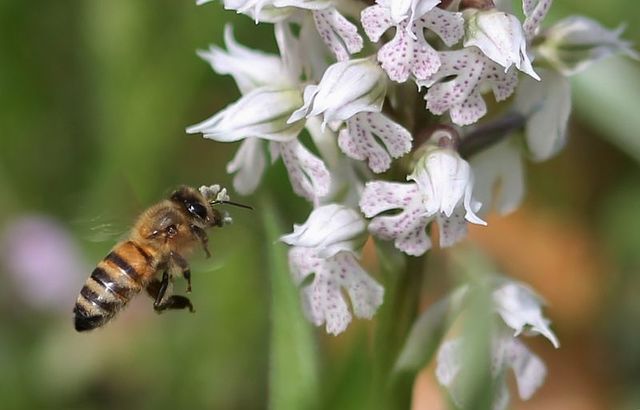After flowering the plant must get pollinated for the fruit to set and for seed formation to take place. Pollination occurs in many different ways in a plant. Some plants self-pollinate, i.e., pollen from the anther settles on the stigma of same plant. These are called cleistogamous plants. Plants which cross-pollinate, i.e., the stigma accepts pollen from plants other than its own self, these are the chasmogamous plants. Orchids being highly diverse and adaptive, do not favour cleistogamy.
For pollination to occur the plant has to work hard at attracting pollinating agents which can be insects, birds and animals. Natural pollinators of orchids include small insects such as bees, wasps, moths etc., and then there are bird pollinators too. Orchids are very specific about their pollinators. This is another reason that deforestation of orchid inhabited areas is affecting the orchid populations around the world.
Orchids have developed interesting ways to entice the pollinators to their flowers. Pollination in orchids is mostly by insects and birds, with some cases of pollination by ants though these do more harm than good! Orchids pollinated by insects have developed certain features (though you can never rule out exceptions) like having a small size, many bribe their insect visitors with nectar, some orchids trick male insects by mimicking the female body parts or its scent. These flowers are normally white or are monochromatic (insects do not see most colours). When an insect visits an orchid flower, the pollen sticks to its body. The structure of the flower is such that pollen is deposited on the stigma of another flower when insect visits it.
Bird pollinated orchid flowers too show some adaptations to facilitate pollination. They are mostly large and showy with vibrant colours, these flowers also show mimicry by developing resembling bird parts. These flowers are normally scentless. Bird pollinators of orchids include humming birds, the sunbirds etc.
To find out an orchid’s pollinator we need to keep tabs at particular times of the day, like in the morning, evening/noon and even at night. My Rhynchostylis retusa has beautiful flowers which produced scent only once and I was able to click an insect visiting my flowers. After shifting from the orchid rich North-Eastern region, I could not get my flowers to pollinated naturally, mainly due to lack of specific pollinators in the present area of residence!
Orchids can be pollinated manually also. It is a very simple and easy technique, just needs practice and more practice. You just need to copy what the natural pollinators do. Not all pollinating attempts (natural or artificial) are successful. If you have tried it and failed, then don’t lose heart but keep trying again. Even experts do not have 100% success each time.
 Bee pollinating a milky orchid photographed near Toulouse (France).
Photography credit: Gilles SALAMA
Bee pollinating a milky orchid photographed near Toulouse (France).
Photography credit: Gilles SALAMA
How Does Your Orchid Pollinate?
Curiosityby Anu Dharmani
Originally published in BellaOnline
Posted by Sys Admin about 9 years ago.This article references Nt. lactea.
Article Blog Article Index
Share on Social Media:
New Topics
- David George asked question Odom's Fascination - an unusual orchid in category General Discussion
- Carol Holdren asked question Grow Tent in the Garage in category General Discussion
- David George asked question rlc Caotan Beauty found at Home Depot in category Cattleya Alliance
- Kristin Dorris asked question Odontocidium Orchid fungus? in category General Discussion
- Maria Fernandez asked question Wild. Lisa Devos in category Dendrobiums
New Comments
- Carol Holdren commented on topic "rlc Caotan Beauty found at Home Depot " by David George
- Carol Holdren commented on topic "Odom's Fascination - an unusual orchid" by David George
- Dr. Florian Wolf commented on topic "Wild. Lisa Devos" by Maria Fernandez
- Michael Valcarcel commented on member plant Rlc. Chief Takanaka by Walceli Muniz Valverde
- Michael Valcarcel commented on member plant Rlc. Montana Spirit by Michael Valcarcel
- Michael Valcarcel commented on member plant Ctt. Blazing Sun by Michael Valcarcel
- Michael Valcarcel commented on member plant Bc. Spotted Clown by Michael Valcarcel
- Maria Skrypnyk commented on member plant Yamadara Redland Sunset by Maria Skrypnyk
- André Pessina commented on topic "Odontocidium Orchid fungus?" by Kristin Dorris
- Linda Hartman commented on topic "Image of a plant please" by Leshya Perkins
- Paul Reavis commented on orchid Milt. Kismet
- Christiaan Viljoen commented on member plant Psh. fragrans by Christiaan Viljoen
- Christiaan Viljoen commented on member plant Z. maculatum by Christiaan Viljoen
- Christiaan Viljoen commented on member plant C. Gaskell-Pumila 'Azure Star' by Christiaan Viljoen
- Robert H. Findlay commented on member plant Rlc. Joy Sokabe var. Volcano Queen by Sally K
- James Lunsford commented on member plant Lc. Sagarik Wax 'African Beauty AMO/AOS x Blc. Cherry Suisse'Kauai' HCC/AOS var. Cattlyea 'Hybrid ' by James Lunsford
- John Varigos commented on orchid Bulb. schwarzii
- Linda Hartman commented on topic "Issue with Blc. Ben O'Neil "Jubilee" by Glenda Ratliff
- Henry Shaw commented on member plant Ons. Catatante 'Los Roble' by Henry Shaw
- Mary Lane commented on member plant Den. Tianmu Canary by Terre Moore